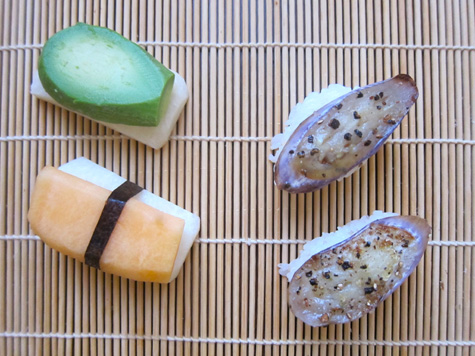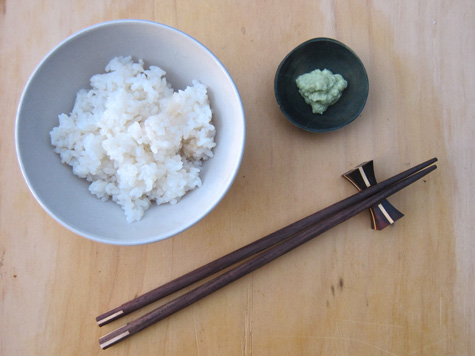
The RAW 101 series is a practical approach for incorporating more living foods into your life. We need to be clever if we’re to succeed when faced with family or friends who are less adventurous eaters. RAW 101 presents delicious and simple companion meals – raw and cooked counterparts – so everybody wins!
In this installment we explore one of my very favorite foods: sushi! At times I get a bit fancy-pants, but that’s only because it’s fun for me. I also cover the absolute basics and the take-away message (I hope) is that, more than anything else, sushi lends itself to flexibility, creativity, and best of all, playfulness. You don’t need the exotic ingredients (though they can be fun). All you need is your own enthusiasm!

Getting Started
Though sushi is truly a platform for epicurean exploration, there’s a few key things that’ll make for a more magical experience. These items should be available at most big supermarkets or smaller health food stores. Specifically Asian or general ‘ethnic’ markets are also great for finding deals.
Nori - Sheets of seaweed that wrap the rolls. Nori is insanely good for you! It’s also almost always toasted, meaning it’s not actually raw. Most raw dabblers I know overlook this detail, and so do I. But if you want to go for purity you can find raw nori online.
Sushi Rice – For your cooked companion. This is more than just white rice! Sushi rice is a special short grain, and mixed with a bit of rice wine vinegar and sugar. Super easy to make at home.
Assorted Additions – All your favorites, whatever you can imagine! Raw veggies of all stripes, raw fruits, grilled or sautéed tofu or tempeh – these are just the basics. Let your mind wander, ’cause there are no rules!
Accompaniments – Shoyu/tamari/soy sauce, wasabi, and pickled ginger are traditional. Nama shoyu is raw.

Making Makizushi
So you’ve got your nori and your rice, your fillings and toppings and dressings and dips. Now what??
Let’s start with a basic, classic roll.

Maki (rolls) In Progress: cooked, left, and raw, right.
Replacing rice is easier than you might imagine! Here, I’ve used almond pulp leftover from making milk. Mixing in a splash of rice wine vinegar and a drizzle of agave will add authenticity of flavor. If you don’t have pulp you can use whole nuts/seeds to whip up a quick paté. I’ve seen people using soaked and blended oats, or finely diced cauliflower. Let yourself be creative!
Once you’ve spread your rice/rice-sub in a thin layer (tip: keep a bowl of warm water handy and dip your fingers frequently to prevent a sticky mess), you’re ready to lay your fillings.

For these I used some old standbys – cucumber, carrot, avocado, and bell pepper. But you can use anything imaginable! Some of my favorites are pickled vegetables, herbs like basil or mint, and um, leftovers. Yup, ANY leftover wrapped up in nori is my idea of a good time. But I may or may not be a big ol’ seaweed weirdo (seaweirdo?).
After arranging your fillings, you’re ready to roll (oh, HA!). A makisu (bamboo matt) may help but it’s by no means necessary. The procedure is actually very similar to rolling a burrito – with the same ‘tuck and tighten’ technique – though you’ll leave the ends open. Wetting the edge of the free flap will allow it to stick to itself and seal. Use a sharp knife to slice it up and rinse the blade between each cut (to prevent pulling). And futomaki is born!

One of my absolute favorite raw riffs is rice-less temaki (a hand roll). Super quick and super easy, it’s also seriously delicious. I use avocado as the base and most often go very light on the veggies. A drizzle of sesame oil compliments the avocado and really takes it over the top!

Simply mash half an avo over your nori. Add whatever fillings you prefer – here I’ve kept it clean with cucumber and sesame seeds.

And then roll it carefully, aiming for a cone shape that’s nearly closed at one end. This takes practice and though my brother was a professional sushi chef, clearly I . . . am not, haha.

Sesame-avocado temake, my favorite!
Getting Funky With Nigirizushi
Nigiri is a two-bite treat, traditionally a ball of rice and a single topping. Nigiri is the perfect way to show off prime ingredients, by letting them sing solo and uninterrupted by other flavors. It’s such a beautiful food form. Fruit is particularly pretty:

Avocado and cantaloupe nigiri, left, and grilled Japanese eggplant nigiri, right.
For the raw nigiri pictured above, I replaced the sushi rice with raw jicama – which worked splendidly! I think a cauliflower floret would be beautiful as well. You could even use banana, but then you’d be straying away from an accurate flavor profile. But of course, you can be creative!
Raw or cooked, vegan sushi is one of the most colorful, most creative ways to try new foods and new preparations. Do you make your own sushi? What’s your favorite combination?


-
Minna
-
http://www.city-vegan.blogspot.com Crystal
-
http://www.windycityvegan.wordpress.com windycityvegan
-
http://www.city-vegan.blogspot.com Crystal
-
http://www.windycityvegan.wordpress.com windycityvegan
-
Meghan
-
Annie
-
Johnna
-
Adrienne Audrey
-
MathTutor
-
http://theamberlily.com/ Lily
-
Rebecca
-
Richard
-
Shango
-
http://twitter.com/erosan erosan
-
Johnna
-
http://www.myqute.com kelly
-
Moki



